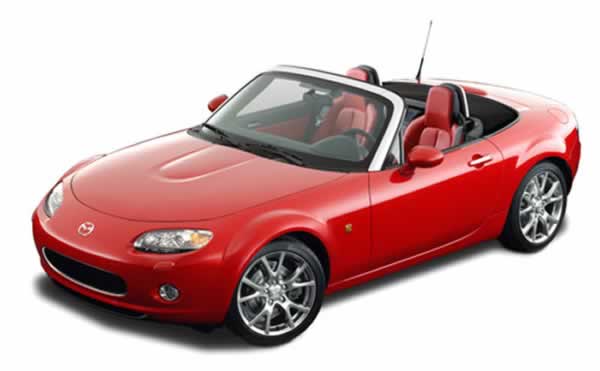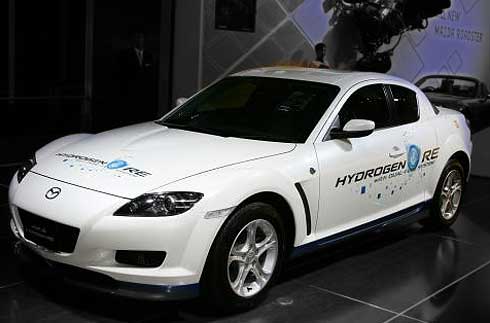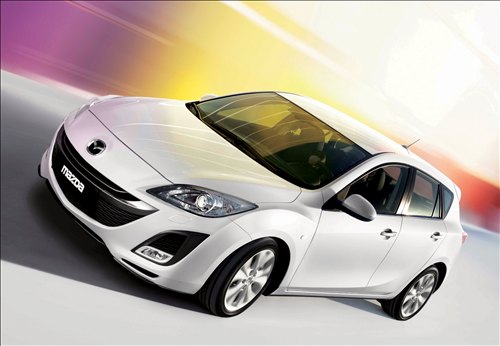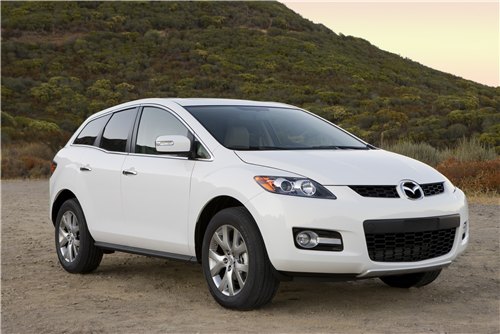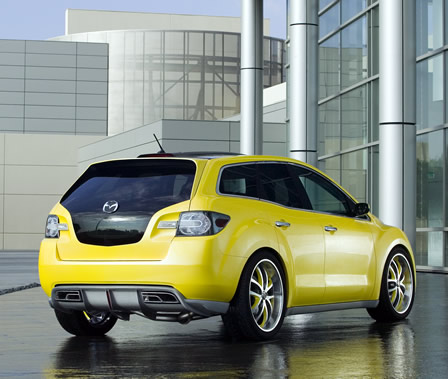2010 Mazda CX9 is equipped with a list of equipment including 4.3-inch color LCD screen full of new, two-stage seat heaters, climate control newly developed, and Advanced keyless entry and start system fob key system.
 Self-POWER, REFINED PERFORMANCE
Self-POWER, REFINED PERFORMANCEThe
2010 Mazda CX-
9 is powered by the
engine 273 horsepower 3.7-liter V6, making the most complex searches easy and enjoyable as possible. Short-stroke 60-degree V6 is state-of-the-art-all. Advanced features including die-cast aluminum block with cast-in iron cylinder liners and aluminum cylinder heads for minimal weight. valvetrain includes chain-driven overhead camshafts dual for minimal
maintenance, four valves-per-cylinder with bucket-type actuators directly acting, and variable intake valve timing. A high 10.3:1 compression ratio maximizes efficiency and power output while the throttle is electronically controlled for instantaneous response. Two close-coupled catalytic converters cleanse the exhaust without inhibiting power.
Computer-assisted analysis of a wide-technique is used to configure the cylinder block casting, to shape intake and exhaust ports, and to design a high volume exhaust system fitted with three large mufflers. Very low back pressure is one reason why the power curve was still rising at the 6500-rpm redline. In addition, forged-steel crankshaft with induction-hard journal, full of the counterweights. Engineering details even extend to the cam-drive sprocket roller chain with rubber coated for quiet operation.
A peak power of 273 horsepower at 6250 rpm to give the
Mazda CX-
9 with sparkling accelerating and passing
performance. -Ft of torque curve continues to 250 pounds from 3000 to 6000 rpm and peaks with 270 lb-ft at 4250 rpm.
To combine excellent acceleration and high fuel mileage,
Mazda CX-
9, including a six-speed Aisin-awarded
Sport AT automatic transmission with
manual mode as standard equipment. area ratios maximize flexibility by providing enthusiastic launch acceleration with quiet cruising. Both the second overdrive gear ratio.
Front-wheel drive is standard on the
Mazda CX-
9 for excellent drivability, with
Mazda's Active Torque All-Wheel Drive optionally available. Also used in the
Mazda CX-
7 crossover
SUV, the system is changing rapidly adjust traction needs by monitoring wheel slippage, steering angle, yaw rate, lateral acceleration and available driveline torque. In normal driving, 100-percent of the torque sent to front-wheel drive. During the acceleration of aggressive or when one front wheel is on the verge of slip, controlled percentage of the available torque is directed to the rear axle.
A power take-off device integrated with the transaxle
Mazda CX-
9's spins a drive shaft attached to an active coupling built into the rear differential. Instructed by the control module, multi-plate clutch servo can be controlled routes from zero to 50 percent of available torque to the rear wheels.
CHASSIS ENGINEERED FOR SAFETY AND PERFORMANCEThe
Mazda CX-
9 has received the U.S. government’s National Highway Traffic Safety Administration (NHTSA) highest possible ratings in frontal and side impact crashes - five stars. In addition, both the FWD and AWD versions of the
Mazda CX-9 received four-star rollover resistance ratings. With five stars to back it up, it comes as no surprise that
Mazda’s advanced engineering provides
Mazda CX-9 with one of the safest unibodies on the market.
Guiding development principles are:
Front frame rails that are large in section and as straight as possible.
A front subframe (supporting the powertrain, suspension, and steering equipment) attached to the unibody at six widely separated points. A forward extension integral to the subframe helps it to more effectively absorb collision energy.
B-pillars securely anchored to members in the floor and rocker areas with increased cross-section for all load-bearing members.
Rear frame rails positioned higher and configured as straight as possible.
Bumper reinforcement manufactured using a hot-stamping technique.
More than a dozen structural members in the floor and roof pillars made of high-tensile steel. Multiple steel reinforcements in the roof and a triple-H-shaped floor structure help absorb side-impact energy.
A fuel tank positioned near the middle of the vehicle and surrounded by multiple torque box crossmembers. Maximum overlap between the doors and the unibody to minimize side-impact intrusion. Energy absorbing material on front and rear door trim diminishes the transfer of impact loads to occupants.
Spot welds, laser welding in high-stress areas, and weld bonding (combination of welding and structural adhesives) to improve unibody stiffness.
Acoustical foam filler applied to internal cavities to block noise transmission from underbody into cabin areas.
Highly rigid damping sheet applied to large expanses of the floor pan to eliminate resonance and to block road noise.
For Mazda CX-9 to wear the
Mazda brand symbol, it had to be more than just another crossover SUV. It had to be a true Mazda, embodying the company’s philosophy “Soul of a
Sports Car.” And so engineers determined
Mazda CX-9 had to have an independent suspension on all four corners.
In front, the perimeter frame mounted to the unibody through six rubber isolators supports the powertrain, the engine-speed-sensitive rack-and-pinion power steering, and a low friction strut-type suspension system using coil springs. The multilink rear suspension consists of one trailing arm and three lateral locating links per side. To minimize cargo-compartment intrusion and permit a wider load space, the rear coil spring is positioned between the lower lateral links and the unibody. A damper is located as close as possible to each rear wheel to provide excellent motion control with minimal friction. Anti-roll bars at each end maximize agility and control during assertive driving.
Twenty-inch, V-rated, low-profile radial tires (P245/50R-20) are standard equipment on the top Grand Touring model while Sport and Touring editions roll on P245/60R-18 tires. As a result, Mazda CX-9 looks and feels unusually nimble for its size and is the clear class leader for driving pleasure.
EYES IN THE BACK OF YOUR HEADThe Blind Spot Monitoring (BSM) system supports the driver when changing lanes on roads and highways. At speeds of 20 mph or more, the system monitors areas on both sides of the vehicle to the rear. When a vehicle enters the detection area on either side, the BSM notifies the driver by illuminating a warning light located in the door mirror in the same side. If the driver then activates the turn signal, indicating a move in the same direction, the warning light will flash and the system will also sound an audible alert to immediately inform the driver of the potential danger in changing lanes.

 ROOM ENOUGH FOR THEIR CHILDREN AND FRIENDSMazda CX-9
ROOM ENOUGH FOR THEIR CHILDREN AND FRIENDSMazda CX-9 rides on 113.2-inch wheelbase, one of the longest in this segment, providing easy access to three rows of seating. There is plenty of room for adults in every position and enough cargo space to accommodate modern American families. Under the sleek exterior is an interior that will impress demanding customers with its space, utility, versatility, and premium features.
For ease of accommodations for all drivers, the driver's seat and steering column move quickly and easily with a long range adjustment. 60-40 split second row with three in comfort and offers approximately five-inches of travel slides lengthwise and lay back. In the third row 50-50 split-position seat and foot space is one of the leaders in class in numbers and real comfort. Log into the third row is easy, with access to almost 26 inches of space between the second row seats folded and the C-pillars. Even with the third row occupied, the Mazda CX-9 provides 17.2 cubic feet of cargo capacity, eclipsing many large sedan trunks. Both the second and third-row seats fold flat to allow additional storage all the way up to the rear of the front seat.
Extra thought is invested in small details, like how the release of the Mazda CX-9 seats are configured. For example, to release second-row seat to enter the third row requires only one simple hand motion to unlatch the seat and move forward. Similarly, a clever strap attached behind the third row seat backrest serves as both a release for folding chairs and means of pulling back upright again.
SAFETY WITH ADVANCED TECHNOLOGYSafety features
Mazda CX-9 is highlighted by advanced Roll Stability Control (RSC) system that uses both body-roll rate and the wheel speed sensors to determine when corrective action is required. Instantaneous torque decline, combined with an automatic brake application, helping to restore the
Mazda CX-9 for the balance.
Four-wheel ventilated disc brakes including
Anti-lock Brake System (
ABS) to prevent the use of prison during an emergency. Dual-caliper front brake pistons operate together with a 12.6-inch ventilated rotors with diameter of 1.1 inches thick. single piston rear calipers squeeze 12.8-inch diameter by 0.71-inch thick rotors, also ventilated. Electronic Brake-Force Distribution (EBD) control the distribution front-to-rear braking force to take full advantage of available traction during stops. In the event the driver applies the brakes quickly in an emergency but with sufficient force to perform the function of ABS, brake assist takes over the function to stop the vehicle as soon as possible. To provide drivers with a confident feel during stops, the system of the
Mazda CX-9's braking an extra-rigid so that deceleration is more directly proportional to pedal pressure than pedal travel. Benefit with a more linear response enhanced controllability.
When excessive wheel slippage is detected, a Traction Control System (TCS) automatically reduces driveline torque to help restore traction. Dynamic Stability Control (DSC) reduces driveline torque and automatically applies one or more brakes to minimize under or over-steer during emergency maneuvers.
Protection is provided by the party-curtain airbags, active sensors, which extend from first to third line. This restriction inflatable lateral spreading in a collision or a rollover to reduce the chance of injury and limb or head ejection. Inflation is maintained for about six seconds for maximum effectiveness, although the only way this system works well is when used in combination with seatbelts. Pretensioner devices automatically remove slack from the belt system immediately after the collision moderate or greater frontal and load limiters are incorporated to provide some give as the occupant moves forward. The front headrests
Mazda CX-
9's include new design features, which are designed primarily to reduce neck injuries during rear impacts.
Mazda CX-9 strong unibody uses the
Mazda Advanced Impact-energy Distribution and Absorption System to help protect the cabin from deformation in case of danger of collision.
The combination of large parts, some of which are made of high tensile steel, envelope the passenger compartment to absorb impact energy while guard against interference.
TRIM AND ENTERTAINMENT FEATURESMazda CX-9 is offered in three trim levels: Sport, Touring and Grand Touring. All models include air conditioning, power windows, power door locks with remote keyless entry, trip computer, cruise control, six airbags, Bluetooth ® phone capabilities and choice of black or beige interior color.
Mazda CX-9 Sport is equipped with 18-inch aluminum wheels and tires, halogen lamps, the ability of Bluetooth ® hands-free phone and upholstery. Power front seat adjusters are optional. Stepping into Touring model adds leather seat trim, power seat adjusters-front. Grand Touring edition rolls on top of 20-inch aluminum wheels. It is also equipped with the Touring equipment plus a bright exterior door handles, rain-sensing wipers, an anti-theft alarm system, exterior mirrors with turn indicators, three-position memory driver's seat, the Blind Spot Monitoring system, HomeLink mirror auto-dimming rearview mirror,
Mazda Advanced keyless entry and Start System, wood instrument panel-like trim, wood door-like trim, indirect blue interior lighting and silver to finish the surface of the rear side of the console. New features for 2010 include:
Redesigned climate control system for rear seat area
Redesigned Advanced keyless entry and start key fob system, which replaces the card design exit button (the Grand Touring model)
New available 4.3-inch, full color LCDs operating system that enables intuitive audio AM / FM radio, MP3-capable CD changer, SIRIUS satellite radio,
auxiliary input jack of the phone, hands-free, and iPod connectivity, and serves as a backup camera screen. (Touring and Grand Touring models equipped with BOSE ® package)
Two-stage heated seats (Touring and Grand Touring standards, available in Sport)
Mazda CX-9 offers as an optional feature factory towing package, power sunroof, BOSE ® audio system, power lift gate and rear seat entertainment system. (Rear seat entertainment system is packaged with the upgraded Bose ® audio system and includes an AC power outlet 115-volt) Navigation. Available as a stand-alone option (on the Grand Touring model) and include a DVD navigation system, and backup monitor. New for 2010, the back-up system monitor is equipped with wide-angle camera, which increases the field of vision, allowing for a broader view of objects or persons who may be behind the vehicle.
All 2010
Mazdas come with a roadside assistance program. With a call to the toll free number, owners can access roadside assistance 24 hours a day, 365 days a year throughout the United States and Canada. In addition, a comprehensive warranty three-year/36 0.000-mile span every section on the vehicle except those that depend on normal usage. Also, all 2010 model
Mazda receive five-year/60, 000 mile powertrain warranty five-year/unlimited-mileage corrosion warranty.














